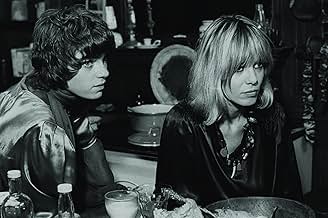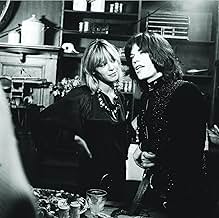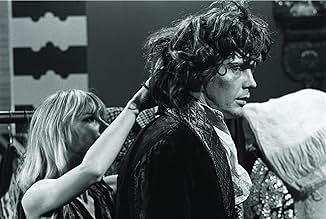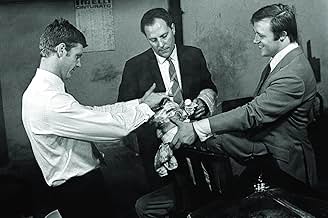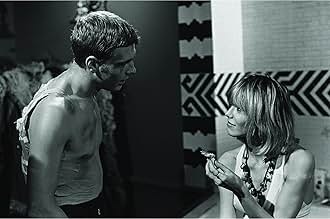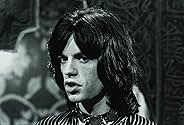ÉVALUATION IMDb
6,7/10
12 k
MA NOTE
Un truand violent recherché par la pègre trouve refuge dans la demeure bohème d'une ancienne rock star.Un truand violent recherché par la pègre trouve refuge dans la demeure bohème d'une ancienne rock star.Un truand violent recherché par la pègre trouve refuge dans la demeure bohème d'une ancienne rock star.
- Nominé pour le prix 1 BAFTA Award
- 1 nomination au total
Michèle Breton
- Lucy
- (as Michele Breton)
Anthony Morton
- Dennis
- (as Antony Morton)
Kenneth Colley
- Tony Farrell
- (as Ken Colley)
Edmond Bennett
- Detective Sergeant
- (uncredited)
Helen Booth
- Noel's mum
- (uncredited)
John Caesar
- Ticket Clerk
- (uncredited)
Jay Denyer
- Constable
- (uncredited)
Histoire
Le saviez-vous
- AnecdotesAccording to Anita Pallenberg, one scene actually shows her shooting heroin, which she was just starting to get into at the time.
- Autres versionsIn most versions the voices of Johnny Shannon, John Bindon and Laraine Wickens have been overdubbed. This was because the actors' own voices were thought to be "too cockney" for non-UK audiences to understand. The 2007 Region 2 DVD (DY11687) features the voices of all three actors throughout the feature, none of the previous overdubs are present in this version.
- ConnexionsFeatured in Memo from Turner (1970)
Commentaire en vedette
As the title might suggest, Performance (1970) is a film to be experienced, as opposed to simply endured. At its most basic level, the film can be seen as an experiment into the nature of personality, role-playing, character and the lines between fact and fiction, reality and fantasy; all blurred together by a heady cocktail of sex, drugs and rock n' roll that is representative of the late 60's art-scene that writer and co-director Donald Cammell was very much a part of. For many it will have no doubt become something of a dated relic; a film from the days when East End gangsters were all sharp-suited mother's boys or closeted homosexuals with Jags' and boxing clubs or 60's radicals with beards in bed-sits dropped acid and strummed endless drones about the doors of perception on electric guitars. Others will see it for what it truly is; a disorientating hall of mirrors of psychology and satire - part Borges, part Carroll - as Mick Jagger's self-destructive rock star becomes a sort of white rabbit figure; leading exiled gangster James Fox into a wonderland of psychological manipulation, mind-games and more.
On a secondary level of content and presentation, Performance can also be seen as a playful subversion of the codes and conventions of early gangster cinema; extending on certain well-worn characteristics of 40's film-noir - with the idea of a disgraced hood forced to hide-out after a botched job gives way to the threat of mob retaliation - whilst creating a continually evocative underworld environment that is rife with a number of recognisable references to the iconic gangland milieu of London's East End. This particular period setting is later contrasted and eventually broken down by the second half of the film, in which a combination of bohemian squalor and 60's decadence erode the carefully created facade that these troubled and enigmatic characters - "performers" even - have exploited in order to progress within their disparate social environments. The lines are further blurred by the use of drugs, which again, parallel the emotional landscapes of Lewis Carroll, as well as the more potent ideas of sex and sexuality, which are here presented as being part of a greater performance in itself.
The film is littered with presentations of sex - both heterosexual and homosexual - and always loaded with the threat of both physical and psychological violence, power and manipulation. The sex is a continual distortion; neither erotic, nor titillating, and seemingly inspired by the paintings of Francis Bacon or Domenico di Michelino. It works in the creation of a heightened atmosphere that becomes continually more oppressive and dangerously claustrophobic as the film develops; with the kaleidoscope of images, sounds and colours all blending and blurring between extended philosophical discussions, violence and transfiguration. From here the film shows the subtle symbiosis between the self-aware rock-star and the naive gangster, as sex and drugs are again combined to break down the boundaries of personality and the literal mirroring between life and death. There are all kinds of different ways that we, as an audience, can interpret these ideas and the relationship between the characters; as Cammell - here in close-collaboration with co-director and cinematographer Nicholas Roeg - creates a continually fascinating atmosphere that is punctuated by abstract thought and dark, surrealist imagery.
As a work of artistic expression and cinematic experimentation Performance is a film that needs to be experienced. It is not only notable as a deep, penetrating expose into the human psyche and the dangerous places that narcissism and self-delusion can carry us when the walls of reality have slowly broken down, but as a time capsule to the creative spirit of the 1960's and a brief bohemian subculture that I for one find incredibly interesting. The film also manages to capture the raw energy and quiet sexuality of Jagger before he became an insufferable cliché (all gyrating, geriatric hips swinging to a packed-out football stadium as he saunters through possibly the 100,000,000th performance of Gimme Shelter), with the seductive energy and shaman-like otherworldliness instead creating a character that is self-aware and clearly self-referential, and yet - so perfectly matched against the brooding uncertainty of Fox's wayward gangster. Likewise, the art-pop, drug culture and obvious psychedelic influences never overwhelm the story; instead feeling absolutely germane to the scene that Cammell and Roeg were attempting to explore and to the themes expressed within the subtle subtext of Cammell's strange and suggestive script.
In hindsight, Performance can be seen as the point in time at which the psychedelic experimentation, expression and drug-culture of the 1960's was allowed to envelope the cinematic medium; extending on the more exciting and progressive films that had been emerging from places like France, Japan or the Czech Republic throughout the years leading up to 1967, and finally creating a complete symbiosis between content, theme, character and presentation that was socially progressive and entirely relevant. If America had films like Easy Rider (1969), Medium Cool (1969) and Zabriskie Point (1970), then we had Performance and 'If...' (1968). And if the latter remains a truly defining masterpiece of British film-making and a testament to the unsung greatness of director Lindsay Anderson, then Performance is the essence of the scene preserved as a sort of cinematic reflection; where the underground met the mainstream and the experience was allowed to take control.
On a secondary level of content and presentation, Performance can also be seen as a playful subversion of the codes and conventions of early gangster cinema; extending on certain well-worn characteristics of 40's film-noir - with the idea of a disgraced hood forced to hide-out after a botched job gives way to the threat of mob retaliation - whilst creating a continually evocative underworld environment that is rife with a number of recognisable references to the iconic gangland milieu of London's East End. This particular period setting is later contrasted and eventually broken down by the second half of the film, in which a combination of bohemian squalor and 60's decadence erode the carefully created facade that these troubled and enigmatic characters - "performers" even - have exploited in order to progress within their disparate social environments. The lines are further blurred by the use of drugs, which again, parallel the emotional landscapes of Lewis Carroll, as well as the more potent ideas of sex and sexuality, which are here presented as being part of a greater performance in itself.
The film is littered with presentations of sex - both heterosexual and homosexual - and always loaded with the threat of both physical and psychological violence, power and manipulation. The sex is a continual distortion; neither erotic, nor titillating, and seemingly inspired by the paintings of Francis Bacon or Domenico di Michelino. It works in the creation of a heightened atmosphere that becomes continually more oppressive and dangerously claustrophobic as the film develops; with the kaleidoscope of images, sounds and colours all blending and blurring between extended philosophical discussions, violence and transfiguration. From here the film shows the subtle symbiosis between the self-aware rock-star and the naive gangster, as sex and drugs are again combined to break down the boundaries of personality and the literal mirroring between life and death. There are all kinds of different ways that we, as an audience, can interpret these ideas and the relationship between the characters; as Cammell - here in close-collaboration with co-director and cinematographer Nicholas Roeg - creates a continually fascinating atmosphere that is punctuated by abstract thought and dark, surrealist imagery.
As a work of artistic expression and cinematic experimentation Performance is a film that needs to be experienced. It is not only notable as a deep, penetrating expose into the human psyche and the dangerous places that narcissism and self-delusion can carry us when the walls of reality have slowly broken down, but as a time capsule to the creative spirit of the 1960's and a brief bohemian subculture that I for one find incredibly interesting. The film also manages to capture the raw energy and quiet sexuality of Jagger before he became an insufferable cliché (all gyrating, geriatric hips swinging to a packed-out football stadium as he saunters through possibly the 100,000,000th performance of Gimme Shelter), with the seductive energy and shaman-like otherworldliness instead creating a character that is self-aware and clearly self-referential, and yet - so perfectly matched against the brooding uncertainty of Fox's wayward gangster. Likewise, the art-pop, drug culture and obvious psychedelic influences never overwhelm the story; instead feeling absolutely germane to the scene that Cammell and Roeg were attempting to explore and to the themes expressed within the subtle subtext of Cammell's strange and suggestive script.
In hindsight, Performance can be seen as the point in time at which the psychedelic experimentation, expression and drug-culture of the 1960's was allowed to envelope the cinematic medium; extending on the more exciting and progressive films that had been emerging from places like France, Japan or the Czech Republic throughout the years leading up to 1967, and finally creating a complete symbiosis between content, theme, character and presentation that was socially progressive and entirely relevant. If America had films like Easy Rider (1969), Medium Cool (1969) and Zabriskie Point (1970), then we had Performance and 'If...' (1968). And if the latter remains a truly defining masterpiece of British film-making and a testament to the unsung greatness of director Lindsay Anderson, then Performance is the essence of the scene preserved as a sort of cinematic reflection; where the underground met the mainstream and the experience was allowed to take control.
- ThreeSadTigers
- 27 août 2008
- Lien permanent
Meilleurs choix
Connectez-vous pour évaluer et surveiller les recommandations personnalisées
- How long is Performance?Propulsé par Alexa
Détails
- Date de sortie
- Pays d’origine
- Langue
- Aussi connu sous le nom de
- The Performers
- Lieux de tournage
- société de production
- Consultez plus de crédits d'entreprise sur IMDbPro
Box-office
- Budget
- 750 000 £ (estimation)
- Durée1 heure 45 minutes
- Couleur
- Mixage
- Rapport de forme
- 1.66 : 1
- 1.85 : 1
Contribuer à cette page
Suggérer une modification ou ajouter du contenu manquant

Lacune principale
By what name was Performance (1970) officially released in India in English?
Répondre

